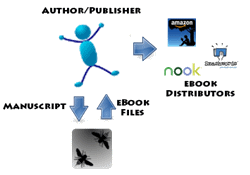
Back when I reviewed Paul Salvette’s book, “The Ebook Design and Development Guide,” I was all about doing it myself. I devoured Salvette’s book and had visions of drop-caps and other features that would make my next book stand out from other self-published books. I was ready and on fire to just do it!
And then I got hit with a cold, hard reality: I suck at HTML, and CSS just confuses me. I’m married to a computer programmer, and he’s got a decent knowledge of HTML, but we ran into a snag I just couldn’t fix. Although the table of contents worked perfectly in the HTML document, I couldn’t get it right in the EPUB.
It’s not the fault of Salvette’s book, which is excellent. If you and HTML get along, I absolutely believe that his book is an excellent guide. It just didn’t work for me.
So I gave in and sent the whole mess to Salvette: HTML file, original manuscript, and what I’d managed to cobble together for a style sheet. A couple of days later, I had EPUB and Kindle files that looked good–mostly. This is where Salvette’s BB ebooks really came through for me.
Because I’m thorough (and own two different e-readers), I loaded the book onto everything possible. The EPUB looked great in Adobe Digital Editions. The Kindle version looked fantastic on my Touch (drop caps and everything!). However, when I loaded the EPUB on my Nook HD, I ran into a snag: The line spacing was wrong. Instead of single-spaced indented paragraphs, I had double-spaced indented paragraphs. Yuck! Switch to “Publisher Settings” mode. The spacing was fine, but the default font was sans serif. Bigger yuck!
I fired back an email, and a day later I had a new Nook file. Still no good. I decided to try something and ran the Kindle file through Calibre to convert to EPUB and made the following changes to the standard conversion:
“Remove spacing between paragraphs.”
“Indent size 1.5 em”
I had no idea if it would help, but I crossed my fingers. The next version incorporated style changes based on my Calibre conversion, and voila! Everything was the way I wanted it.
Now, I want to make something clear. The strength of a company lies in how they handle problems, not in just doing it right the first time. Sure, it would have been great if everything had worked from the beginning, but then I wouldn’t have been able to evaluate how they work when something went wrong. They were prompt, helpful and polite at every step of the way, just like a great company should be.
Did this all cost a fortune? Not at all. Check out the quotes on their site. I bill at $125 an hour in my coaching business. I cringe at the money I “spent” fiddling with this all myself (5 hours, at least). Their standard quote is less than half an hour at my rate.
If you’re self-publishing a book, it’s well worth hiring someone to do the conversion for you. And BB ebooks is now my go-to company to refer (and use for every book in the future.)
Want to check out their work? If you’ll forgive the blatant self-promotion, here’s where you can find my latest book, “The Case of the Werewolf Puppy,” at Amazon, Barnes & Noble and Kobo.


































Well I would be wary about using your Calibre settings:
“Remove spacing between paragraphs.”
“Indent size 1.5 em”
First if your ebook has “non indented” first paragraphs and say non indented scene break paragraphs, these new settings will remove all non indents. Plus it will will probably offset any centered images or text by the 1.5 em you have chosen. And if you don’t have a break space between scene breaks you will lose any spacing with your “Remove spacing between paragraphs” setting. Better to learn about CSS and do the changes yourself. Calibre is not the way to go to do CSS edits. Sigil is the better software to edit epubs.
You’re assuming they used the CSS directly from Calibre (which they didn’t). No, I didn’t lose any of the things you mentioned above. It just gave them an idea of where/how to tweak the CSS for the Nook version.
The point of my article is that it’s better to hire someone who knows CSS than to muck about it yourself (as I had been doing) and that they were willing to work with me until everything was correct.
Also, that as an author, it’s a good idea to know exactly what you want, so you can work with the company to be certain you’re getting it.